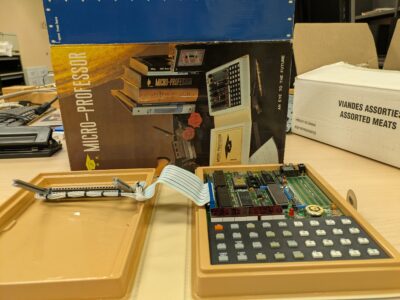Multitech Micro-Professor MPF-I
[Vin50]
The Multitech Micro-Professor MPF-I, launched in 1981, was a compact, book-shaped single-board computer designed primarily as an educational tool for learning Z80 assembly and machine code programming. Its most notable features included a Zilog Z80 CPU, a unique six-digit 7-segment LED display, a hexadecimal keypad, and a form factor that allowed it to be stored on a bookshelf like a textbook, complete with built-in storage for manuals and cassettes.
Its claim to fame lies in its widespread use as a training computer in technical schools and colleges worldwide, helping a generation of engineers and programmers learn low-level computing and embedded systems design. The MPF-I was important in computing history as one of the first branded products from Multitech (which became Acer), and it became one of the longest-selling computers of its kind, with at least 10,000 units sold and ongoing production by Flite Electronics decades later.
- Manufacturer: Multitech, a Taiwanese company that later became Acer
- Type: Single-board microcomputer
- Model: MPF-I
- Release Date: 1981
- Cost at release: USD $149 as a kit (CAD ~$584 adjusted for inflation)
- MIPS: 0.58 (580 KIPS)
Hardware Specifications
- CPU: Zilog Z80 microprocessor running at 1.79 MHz
- RAM: 1 KB RAM (expandable via add-on boards)
- ROM: 2 KB ROM (with monitor program and BASIC interpreter)
- Six-digit 7-segment LED display for output
- 20-key hexadecimal keypad for input
- Cassette interface for program storage and loading
- Edge connector for expansion (I/O, RAM, printer interface, etc.)
- Compact, book-shaped single-board design
- Built-in speaker for simple sound output
Operating System & Programming Languages
- Operating System: The Micro-Professor MPF-I did not use a conventional operating system; instead, it relied on a 2 KB monitor ROM that provided basic system control, program entry, and debugging functions
- Supported Languages: Programs could be written and run in Z80 machine code and assembly language, entered directly via the hexadecimal keypad
Notables
- The MPF-I was Multitech’s (later Acer’s) first branded computer product and became one of the world’s longest-selling computers.
- Its “book-like” plastic case was designed to blend in on a bookshelf, storing manuals and cassettes inside—a highly unusual form factor for a computer.
- It was nicknamed “Micro-Professor” and sometimes referred to as “MPF-1,” “MPF-1A,” or “MPF-1B” depending on the variant.
- The MPF-I was pivotal in education, widely used in technical schools and colleges for teaching Z80 assembly and machine code programming.
- Its hexadecimal keypad and six-digit 7-segment LED display made it look more like a calculator than a typical computer, which was unique for its era.
- The system’s modularity allowed for easy expansion with additional ROMs, RAM, and peripherals, and it inspired a variety of third-party educational kits and add-ons, especially in Europe.
- The MPF-I’s legacy includes its role in launching Acer as a global computer brand and its continued use in educational settings decades after its release
Donated by: Arlen Michaels
